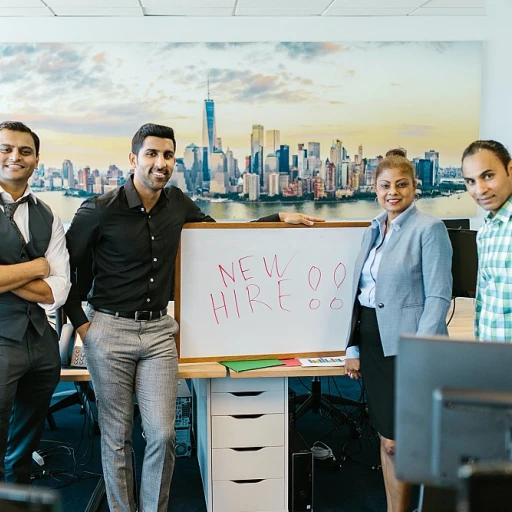Understanding Workforce Planning Essentials
Core Components of Workforce Strategy
Understanding the essentials of workforce planning begins with appreciating its core components. At its heart, workforce planning is about strategically aligning an organization's personnel needs with its business objectives. By evaluating the current workforce and forecasting future needs, businesses can ensure they have the right people in the right positions at the right time. This process involves analyzing current workforce capabilities, identifying skills gaps, and anticipating future trends.
Importance of Data and Analytics
A critical aspect of effective workforce planning is the use of data and analytics. By leveraging data, organizations can make informed decisions about recruitment, training, and development strategies. Analytics also allow companies to predict turnover rates and determine the best ways to retain talent. This data-driven approach ensures that workforce plans are not just reactive but proactive, enabling companies to stay ahead in a competitive market.
Aligning with Business Goals
Another key element is aligning workforce planning with overall business goals. Companies need to ensure that their workforce strategy supports their long-term objectives and addresses upcoming challenges. This alignment helps organizations remain flexible and capable of adapting to changes in market conditions.
To gain a deeper understanding of these crucial components, explore our comprehensive guide on workforce planning.
Key Resources for Workforce Planning
Navigating Workforce Planning Tools and Resources
To successfully implement workforce planning strategies, leveraging the right resources can make all the difference. These resources encompass a range of tools and platforms designed to streamline the planning process, offering insights that align with business goals.
Consider incorporating the following essentials in your journey:
- Data Analytics Platforms: These tools gather and analyze workforce data, providing actionable insights into workforce demographics and productivity trends. Platforms focused on strategic workforce planning can help predict future workforce needs.
- Strategic Planning Software: Software solutions aid in aligning business strategy with workforce capabilities, ensuring cohesive planning. This approach ensures the alignment of workforce needs with organizational objectives, as comprehensively outlined in this strategic workforce planning framework.
- Training and Development Resources: These resources ensure your workforce is equipped with the necessary skills for both present and future demands. Investing in training materials and programs enhances the overall capability of your team.
- Market and Industry Insights: Understanding labor market dynamics is crucial. Subscribing to industry-specific reports can provide valuable context for workforce trends and help you stay ahead in planning efforts.
Each resource plays a pivotal role in crafting a workforce planning strategy that not only meets current requirements but also anticipates future workforce needs. By integrating these tools into your strategy, you'll better navigate the complexities of workforce planning, ensuring alignment with broader organizational goals.
Best Practices in Workforce Planning
Implementing Proven Strategies for Success
Crafting an effective workforce planning strategy requires a grasp of concrete practices that align with both organizational goals and workforce dynamics. The landscape of workforce planning is ever-evolving, yet some core strategies remain central to success.- Data-Driven Decision Making: One of the essential elements involves leveraging data analytics to forecast labor market conditions and predict future workforce needs. Data-driven approaches help organizations make informed decisions about hiring, development, and retention.
- Flexible Workforce Models: Flexibility in workforce models, such as hybrid work systems and adaptive workforce structures, is crucial in today's dynamic environment. Allowing flexibility not only enhances employee satisfaction but also prepares the organization for unpredictable changes.
- Continuous Learning and Skill Development: Prioritizing ongoing learning and upskilling programs ensures that the workforce is equipped to handle future challenges. Workforce planning that includes succession planning and career development paths is vital to maintaining a competitive edge.
- Collaboration with External Partners: Establishing alliances with educational institutions and professional organizations can provide insights into emerging skill demands and labor trends. Moreover, attending events or gatherings can be an excellent way to network and glean best practices, such as those happening in San Francisco.
- Alignment with Business Strategy: It is imperative that workforce planning is seamlessly integrated into the broader business strategy. Keeping a clear focus on long-term business goals ensures that workforce efforts contribute directly to achieving organizational success.
Guides for Effective Workforce Planning
Steps to Developing a Strategic Workforce Plan
Crafting a strategic workforce plan involves a series of methodical steps designed to align organizational goals with workforce capabilities. Here are several essential steps to guide you:
- Define Objectives: Clearly articulate the goals and expectations of your workforce plan. This aligns efforts with overarching business objectives and sets a clear roadmap for evaluation.
- Conduct Workforce Analysis: Use data-driven approaches to understand the current workforce composition, including skill sets, performance metrics, and future needs. This analysis informs decision-making processes and identifies potential skills gaps.
- Forecast Demand and Supply: Anticipate future workforce needs by evaluating market trends, technological advancements, and organizational changes. Compare this with current workforce supply to identify gaps and surpluses.
- Develop Action Plans: Create specific strategies to address identified gaps. This may include recruitment initiatives, employee development programs, or retention strategies designed to build and maintain a skilled workforce.
- Implement and Monitor: Implement the workforce plan with clearly assigned responsibilities and timelines. Regularly monitor progress and adjust strategies as necessary to ensure alignment with business objectives.
- Review and Revise: Workforce planning is an ongoing process. Continuously review and update the plan based on feedback and changes in the internal and external environment. This ensures the plan remains relevant and effective.
These steps form the scaffold of effective workforce planning, enabling organizations to not only anticipate future needs but also to strategically align their workforce with future objectives. By following these guidelines, companies can enhance efficiency and ensure sustained growth and competitiveness in an ever-evolving marketplace.
Frameworks Tailored for Workforce Planning
Frameworks for Strategic Workforce Planning
In workforce planning, frameworks serve as structured approaches to align human resources with organizational goals. These frameworks provide a roadmap, ensuring that every step taken is strategic and purposeful. Here are some essential components and frameworks tailored for effective workforce planning:
- Scenario Planning: This framework involves creating various future scenarios to anticipate potential challenges and opportunities. By preparing for different outcomes, organizations can adapt quickly to changes in the market or workforce dynamics.
- Competency Frameworks: These frameworks focus on identifying and developing the skills and competencies required for current and future roles. They help in aligning training and development efforts with the strategic needs of the organization.
- Workforce Segmentation: Segmenting the workforce based on skills, roles, or other criteria allows for more targeted planning. This approach helps in understanding the specific needs of different workforce segments and tailoring strategies accordingly.
- Gap Analysis: A critical component of workforce planning, gap analysis involves assessing the difference between current workforce capabilities and future needs. This analysis helps in identifying areas that require development or additional resources.
These frameworks are not just theoretical constructs; they are practical tools that can be customized to fit the unique needs of an organization. By integrating these frameworks into your planning process, you can ensure a more robust and adaptable workforce strategy.
Overcoming Challenges in Workforce Planning
Addressing Workforce Planning Obstacles with Confidence
Effectively implementing workforce planning involves addressing several challenges that can arise during the process. Recognizing these hurdles and considering solutions is crucial for a successful outcome. Below are some common challenges and strategies for overcoming them:- Data Limitations: Reliable data is the backbone of workforce planning. Aggregating data from various sources can be cumbersome, yet ensuring data accuracy and consistency is paramount. Utilize technology solutions and software that align with your business needs to consolidate data effectively.
- Change Resistance: Employees may resist changes due to a lack of understanding or fear of the unknown. Clear communication is essential. Establish open channels for feedback and provide training sessions to help employees understand the benefits and implications of workforce planning initiatives.
- Alignment with Business Goals: Integrating workforce planning with the organization’s strategic objectives is essential. Regularly review and adapt your planning strategies to ensure alignment with evolving business goals, prioritizing resources where they are most needed.
- External Factors: Unforeseen changes in the market or industry can impact workforce needs. Develop flexible plans that allow agility to cater to such fluctuations, ensuring your strategy remains relevant and efficient.
- Cultural Differences: In a globalized economy, managing cultural differences in multinational companies can pose a challenge. Embrace diversity and foster an inclusive workplace culture by considering cultural sensitivities in workforce planning decisions.









